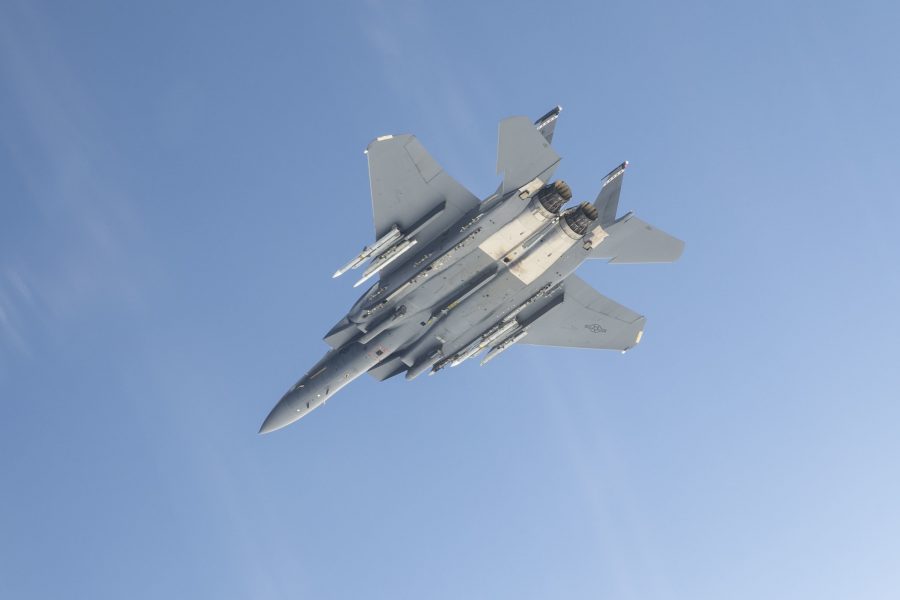The Air Force is looking for “novel” approaches to a new class of faster and longer-range air-to-air missiles, according to a request for information released May 5, but it’s not clear how these new weapons would complement several existing new dogfight missile programs.
The solicitation, released by Air Force Materiel Command’s Air Force Research Laboratory, at the Eglin weapons directorate, seeks industry ideas for technologies applicable to new dogfight missiles, which presumably would improve or replace the current generation of AIM-120 AMRAAM and AIM-9X Sidewinder, and complement the secretive AIM-260 Joint Advanced Tactical Missile. The AFRL wants companies to indicate their interest to work on the project by June 18. It did not say when a program of record might begin. AFRL’s point of contact on the solicitation could not be reached, and AFMC had no immediate comment.
In a Q&A to appear in the June issue of Air Force Magazine, Air Combat Command chief Gen. Mike Holmes said the Air Force needs fifth-generation weapons to go with its fifth-generation platforms.
“We’ll have to continue to make sure our weapons evolve like the platforms do,” he said. “We need weapons that can fit inside the weapons bays of our fifth-gen platforms, the F-22 and the F-35, and then we need weapons that can survive against those future threats and make it all the way to their target.” The AIM-260 JATM is one of those, he said.
Asked if the Air Force expects to get a big jump in loadout—the number of weapons that can be carried—per airframe, Holmes said, “It’s hard to push out and get the same range with a smaller weapon. So, we’ll be building a range of weapons that fit inside those weapons bays, and I’m not really going to talk about how many will fit in there.”
According to the AFRL notice, the new missiles have to fit inside the weapon bays of fifth-generation fighters and not exceed 156 inches. AFRL is willing to consider single or multi-stage rocket motors, or an air-breathing system, but is keenly interested in “multi-pulse solid rocket motors” that can be throttled, along with innovative “propellants, grain configurations, cases, and liners.” The Air Force wants a missile faster than the ones it has already, with “compact design” warheads having “high single-shot probability of kill.” It wants “novel” airframes and compact control systems, advanced battery technology, and ultra-capacitors in the power system.
The Air Force will also consider “novel carriage and release concepts,” and wants “advanced power delivery” and “advanced data transmission.”
“Key considerations” for the new weapons, include:
- Technical feasibility
- Performance
- Resource availability
- Cost
- Manufacturability
The solicitation did not mention that it wants missiles smaller than those now in use. Because fifth-gen aircraft must carry weapons internally to stay stealthy, smaller weapons can increase the number of rounds each can carry. Senior USAF leaders have in recent years touted increasing loadout as one of their top requirements for new air-launched munitions.
Last year, the Air Force quietly disclosed that, in concert with the Navy, it is developing the AIM-260 to replace the AMRAAM, and that Lockheed Martin is the prime contractor. Few details of the new weapon have been revealed, although USAF officials said the weapon will have substantially more range than the AMRAAM in order to compete with the Chinese PL-15 air-to-air missile, which has an estimated range of more than 100 miles, and a dual-pulse rocket motor. The AIM-260 is to achieve initial operating capability in 2022.
Program Executive Officer for Weapons Brig. Gen. Anthony Genatempo told Air Force Magazine last summer that AIM-260 is meant to be “the next air-to-air dominance weapon” for fighters. He said it would have range greater than AMRAAM and “different capabilities onboard to go after that specific threat set, but certainly longer legs.” He said the missile is not an air-breathing weapon.
An even more closely-held air-to-air missile program is the Long Range Engagement Weapon, being developed by Raytheon. That munition is expected to be a two-stage missile.
Lockheed has previously promoted an air-to-air missile it called the “Cuda,” which would notionally be half the length of the AMRAAM but with similar or longer range. In 2013, at AFA’s Air, Space & Cyber conference, Lockheed displayed a model of the F-35 with 12 Cudas carried internally. The F-35 can only carry four AMRAAMs internally, but Lockheed last year said it could modify the aircraft to carry two more, giving it the same AMRAAM loadout as the F-22.
Nine months ago, Raytheon announced a new air-to-air missile called the Peregrine, touted as half the size and weight of AMRAAM and AIM-9X, and available as a “supplement” to those inventories, but with longer range. It is being developed with Raytheon’s own funds, and company officials said Peregrine is not aimed at a specific stated requirement from the Air Force or Navy.
“We’re able to take the best of” the Sidewinder and AMRAAM, “and, based on what we see as the customer’s requirements and gaps … combine them into this new missile,” Raytheon business development manager Mark Noyes told Air Force Magazine at the time. He said the Peregrine would be six feet long and 150 pounds, and have a multi-mode seeker including imaging infrared, with a blast-frag warhead. Noyes said the Peregrine was designed to complement the existing missile portfolio to help the services “overwhelm” an adversary.
